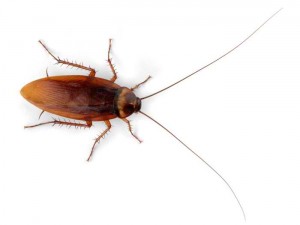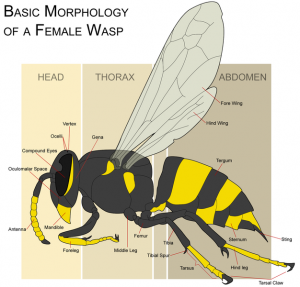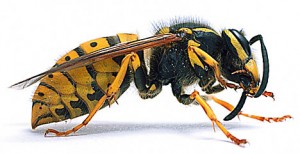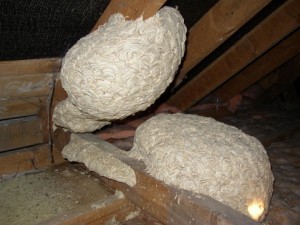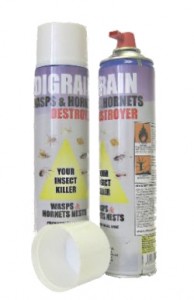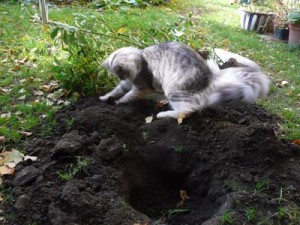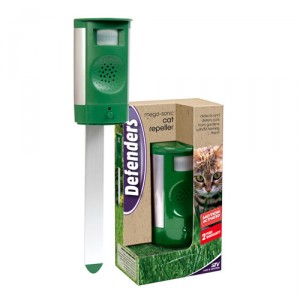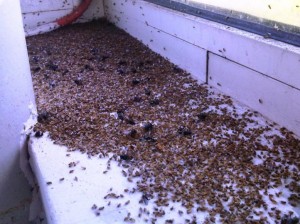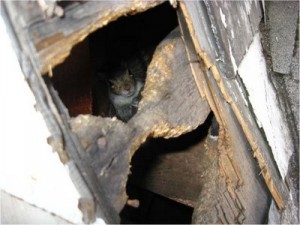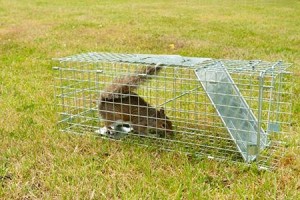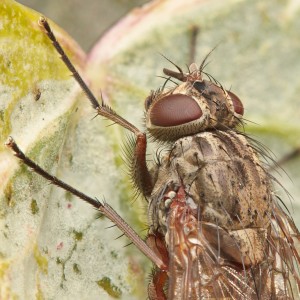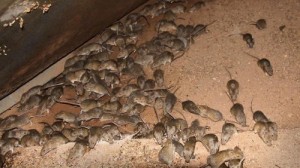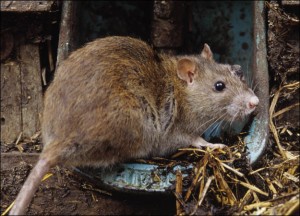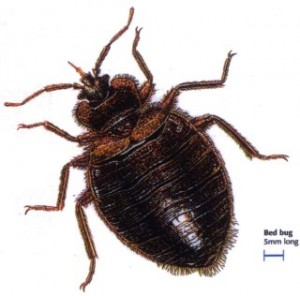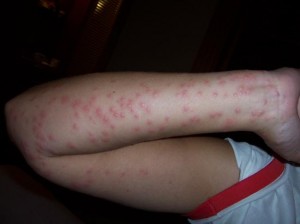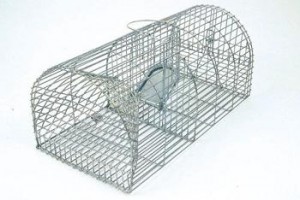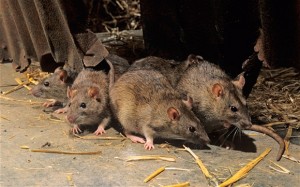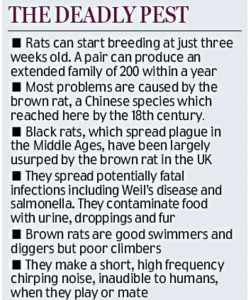Cockroach House Invasion
Cockroaches are insects of the order Blattaria or Blattodea, of which about 30 species out of 4,500 total are associated with human habitats. About four species are well known as pests.
Among the best-known pest species are the American cockroach, Periplaneta americana, which is about 30 mm (1.2 in) long, the German cockroach, Blattella germanica, about 15 mm (0.59 in) long, the Asian cockroach, Blattella asahinai, also about 15 mm (0.59 in) in length, and the Oriental cockroach, Blatta orientalis, about 25 mm (0.98 in). Tropical cockroaches are often much bigger, and extinct cockroach relatives and ‘roachoids’ such as the Carboniferous Archimylacris and the Permian Apthoroblattina were not as large as the biggest modern species.
Where are cockroaches found?
Cockroaches live in groups and are attracted to humidity, warmth and darkness, and are common in bathrooms, kitchens, dining rooms and sometimes bedrooms. Cockroaches secrete a pheromone (an attractant chemical) in their faeces, which attracts other cockroaches. Cockroaches dislike light and hide as soon as a light is turned on in a dark room. This habit can be used to find their hiding places. Egg cases (Oothecae) of some species of cockroaches can be found cemented to and/or dropped inside kitchen cabinets, behind refrigerators, and under or behind stoves. Though not all types of cockroaches drop their egg cases, empty shells of egg cases are an indicator of their presence.
What do cockroaches feed on?
Cockroaches feed on a wide variety of food (grease, crumbs, pet food, wax, gum, leftover food in empty food cans etc.). They also eat paper if it has glue on it, and some will feed on soap bars. Cockroaches can withstand long periods of starvation and can live for many days without water.
Do cockroaches transmit disease?
Cockroaches are scavengers. While walking on spoiled food in garbage containers, they pick up various bacterial organisms on their legs that they can later deposit on uncovered food. Cockroaches themselves are not implicated in the transmission of any diseases. However, many disease-causing organisms can grow and multiply in their guts and can then be deposited on silverware, plates etc. during defecation. For example, cockroaches can pick up disease-causing bacteria like Salmonella on their legs and later deposit them on foods and cause food poisoning. People continuously exposed to dust containing cockroach feces and crushed body parts become sensitized and may show allergic reaction and asthma after repeated exposure to such dust.
How can I control cockroach infestation in my home?
The key to prevent cockroach infestation indoors is sanitation both in and around the house. Empty garbage daily and keep the lid tightly closed at all times. Do not accumulate empty soda cans, beer bottles, food cans and especially not in brown paper bags and cardboard boxes inside the house. Tape openings around pipes under the kitchen and bathroom sinks to prevent infestation from neighbouring apartments. To prevent the entrance of cockroaches into homes: eliminate potential habitat areas outside the houses; seal cracks; and install screens on vents, windows and doors.
Baits are a safe way to control an infestation inside the home. Place bait under your refrigerator, behind and under the stove, and in the basement. Baits contain slow-acting poison that kills any cockroaches that eat it. Once poisoned, they usually salivate or defecate in their nest area, depositing poison that will kill other cockroaches.
Boric acid is used to control cockroaches, but its proper placement and use is essential to ensure its effectiveness. It can be purchased as boric acid insecticide formulations from hardware and grocery stores. The insecticide formulation packaged in plastic, squeezable bottles with narrow nozzles is the safest and easiest to use. Boric acid should be applied as a very thin layer of powder that the cockroaches cannot distinguish from dust. Apply it under and behind refrigerators, stoves, dishwashers, washing machines, cabinets, areas where plumbing pipes enter the floor, under sinks, etc. Do not apply it in areas where you prepare and/or store foods. Boric acid is a poison, so you should always store and apply it properly, especially if you have young children.
‘Wasp Invasion On It’s Way’ Warn Experts
The term wasp is typically defined as any insect of the order Hymenoptera and suborder Apocrita that is neither a bee nor an ant. Almost every pest insect species has at least one wasp species that preys upon it or parasitizes it, making wasps critically important in natural control of their numbers, or natural biocontrol. Parasitic wasps are increasingly used in agricultural pest control as they prey mostly on pest insects and have little impact on crops.
https://en.wikipedia.org/wiki/Wasp
Diet
Generally, wasps are parasites or parasitoids as larvae, and feed on nectar only as adults. Many wasps are predatory, using other insects (often paralyzed) as food for their larvae. In parasitic species, the first meals are almost always derived from the host in which the larvae grow.
Several types of social wasps are omnivorous, feeding on a variety of fallen fruit, nectar, and carrion. Some of these social wasps, such as yellow jackets, may scavenge for dead insects to provide for their young. In many social species, the larvae provide sweet secretions that are consumed by adults. Adult male wasps sometimes visit flowers to obtain nectar to feed on in much the same manner as honey bees. Occasionally, some species, such as yellow jackets and, especially, hornets, invade honey bee nests and steal honey and/or brood.
Although 11 species of true wasp are found in Europe, only two, the Common Wasp (Vespula Vulgaris) and the German Wasp (Vespula Germanica) are important as pest species. Both species overwinter as queens, the Common Wasp usually hibernates in buildings and the German Wasp typically overwintering under the bark of trees.
In spring the overwintering queens leave their hibernating quarters to seek nesting sites which could be in a hole in the ground, a hollow tree or artificial structures such as eaves, lofts and attics, garden sheds etc. The queen starts to build her nest with a papery material that she makes by chewing small pieces of wood mixed with saliva; this is known as Wasp paper. She will raise the first few workers by her own efforts and those workers will then commence the enlargement of the nest and caring for the immature Wasps to follow. Nest construction starts in earnest in June and will reach its maximum in size in September, when 5 – 10,000 workers may be present. These workers will forage for food up to 400 metres from the nest. The size of wasp colonies will vary from year to year, the severity of the previous winter is probably the key factor. In the Autumn the young queens mate and leave the nest to hibernate, the rest of the nest dies out and the nest is never used again.
Individuals react differently to being stung by wasps; some are hardly affected, others suffer considerable pain and swelling and a few become seriously allergic to being stung, which in some cases results in sudden death due to anaphylactic shock.
Control
It is always advisable to let a professional Pest Control Officer deal with a Wasp nest for the reasons mentioned above. An insecticide will be used to cover the entrance to the nest. Returning wasps will carry the insecticide into the heart of the nest and within a few hours all wasps should be dead. Finding the nest is not always easy but following the flight pattern from a source of food could prove helpful. If a householder elects to treat the nest themselves, treatment should be carried out early or late in the day when the Wasp activity is at a minimum. Hardware shops and garden centres will sell insecticide sprays and powders for the treatment of Wasps but care must be taken to follow the instructions on the label.
How To Keep Cats Away
I am often asked how to keep cats away from yards. Cats are unpredictable, so there are few sure-fire cat repellents. But below I consider some of the best approaches known to keep cats away from yards. Broadly speaking, we can label all of these diverse approaches as “cat repellents,” since they are all designed to repel unwanted feline intruders from a specific area. But I’ll also provide an example of the commercial products more narrowly associated with the label, “cat repellents,” namely, products that come in a can and are sprinkled on the ground to keep cats away.
A Cat Repellent Before You Even Begin
If you haven’t planted a flower bed yet, but you anticipate having trouble keeping cats out of your yard, be aware that one of the most effective cat repellents is readily available at most any hardware store: chicken wire.
No, I’m not going to suggest you erect a chicken-wire fence. Instead, lay chicken wire down on top of your soil (or mulch, if you’re using mulch in the bed), across the planting bed, before you plant. Why? Because cats disdain walking on chicken wire. Using wire cutters, you’ll be able to open up pockets in the chicken wire sufficiently large for installing your plants.
Cat Repellents After the Fact: 10 Ways to Keep Cats Away From Yards
But what if it’s too late for the chicken-wire option? Not to worry. The ten cat repellents on which I focus below are all intended for existing garden beds. While on the subject of wire, I’ll begin with electric wire fences.
1. Like rabbits, cats can be kept away humanely with the Mr. McGregor Fence. This fence is so safe that even Responsible Consumer.Net recommends it.
Water: The Ultimate Cat Repellent?
Sometimes, to keep cats away from a yard, you have to think like a cat. Put yourself in the cat’s place. Observe cat behaviour. For instance, they’re pretty fussy creatures, aren’t they?
One of the things cats are fussy about is getting wet. Water is “kryptonite for cats.” Getting wet seems to be almost a phobia for them. Use that phobia to your advantage in trying to keep cats away from yards.
2. When you catch cats in the forbidden area, you can try hosing them down with a Super Soaker or similar water gun. Such action may reinforce the notion that they are unwanted in your planting bed.
3. But if that doesn’t work, you can go hi-tech. Devices such as Scarecrow Sprinklers detect an intruder’s presence and fire a blast of water at it.
Thinking like a cat again, another thing we can say cats are fussy about is how something smells. You can use feline fastidiousness to keep cats away from your yard in a number of ways:
Commercial Cat Repellents
4. One of the commercial cat repellents available is a powder called, “Shake-Away.” Shake-Away bears the scent of the urine of predators that cats fear, namely, the coyote, the fox and the bobcat. This commercial cat repellent comes in a granular form, which you simply sprinkle around the problem area. The product is advertised as being organic, making it an acceptable option to use around children and pets. Nor will it harm your plants.
Plants That Are Cat Repellents
5. Some plants give off smells that cats dislike. One such plant, Coleus canina, goes by the common name, “scaredy cat plant.” As the second term in the Latin name indicates (think “canine”), it is also effective if you have trouble landscaping with dogs. Other plants often recommended for keeping cats away from yards are:
• rue,
• lavender, which deer pests also dislike
• pennyroyal
Other Substances That Double as Cat Repellents
6. Try sprinkling “stinky” substances around the problem area, including:
• dried-blood (“blood meal”) fertilizer
• mothballs (drop them into a can or jar, cover, and make a few holes in the cover)
• cayenne pepper flakes (but see below)
Note that mothballs are toxic, thus the recommendation that you use them in a covered can or jar. Avoid even this usage if small children will be in the yard and could, potentially, open such a can or jar. Note also that some people caution against using cayenne pepper in this fashion, saying it can be harmful to cats. So if you’re an animal lover or tend to be on the cautious side, then save the cayenne pepper to flavour your food!
http://landscaping.about.com/od/pestcontrol/a/cat_repellents.htm
Still “thinking like a cat” to figure out how to keep cats out of gardens, let’s consider something else cats are fussy about: the texture of what they step on. After all, it’s not for nothing we have the expression, “pussyfooting around.” I already mentioned chicken wire in this context.
How to Keep Cats Out of Your Garden: No “Pussyfooting Around”
7. Cats don’t like to walk on bristly material. So in mulching the problem bed, include something on which the refined paws of cats will fear to tread, such as sharp-edged pine cones.
8. Another mulch-related idea is to use stone mulch. It may not be the most attractive mulch for your particular bed, but cats prefer to poop in loose dirt. Cats usually won’t bother with an area mulched in stone. They’d rather be “pussyfooting around” where the digging’s easier on their paws.
How to Keep Cats Out of Your Garden: Striking a Compromise
As in landscaping with dogs, sometimes the path of least resistance provides the best solution to your problem. Strike a compromise with your cat by planting a separate bed of catnip plants, in another part of the yard. Not all cats go nuts over catnip plants, but those who do may come to view their “catnip patch” as their own private sanctuary.
9. Better still, make a sandbox just for cats and keep it in close proximity to the catnip plants. Chances are that the sandbox will serve as a magnet for cat poop. Sure, you’ll have to clean up the cat poop afterwards. But at least you’ll know where it is.
How to Keep Cats Out of Your Garden: Hi-Tech to the Rescue, Again
Hi-tech approaches to keeping cats out of gardens don’t stop with the motion-activated sprinklers mentioned. You can also keep cats out of gardens using ultrasound.
10. Simple to install, this sonic cat scarer can be set up within seconds. Effective in all weather conditions, it also provides 50% more coverage than other cat repellers on the market. One unit can protect a garden of up to 40 feet in length. For larger gardens the repeller can be used solely to target problem areas or in multiples to cover the entire area. The ultrasonic frequency emitted is inaudible to humans, so will not hinder your enjoyment of your outdoor areas.
Cluster Flies In Your House?
During the summer months these flies live and breed in grassy fields and are seldom noticed. In the autumn they would, under natural conditions, hibernate in dry sheltered areas such as under loose bark or in hollow trees. The survivors of the winter would then emerge the following spring to return to the grassy fields to continue their life cycle.
However, with the encroachment of housing onto green field sites bordering pasture land it is quite common in the autumn for these flies to collect in large numbers on the outside of buildings, especially on sunny, light coloured walls. As the night time temperatures begin to fall they tend to crawl into crevices for shelter, sometimes through ill fitting windows and frames, but mainly under the eaves/fascia boards into the roof space.
The following days they may emerge and sun themselves but finally they remain inside until the process is reversed the following spring.
These flies may then be discovered when you enter your attic (to retrieve your Christmas decorations?). Your attic light is enough to make some think spring has arrived and they will sleepily buzz around. This usually kills them as they use up vital energy which is needed to keep them through the winter.
My House Is Affected By Cluster Flies – What Should I Do?
In most circumstances no insecticidal treatment is needed nor warranted. Unlike most other flies, cluster flies do not carry nor transmit disease. They are at worst a nuisance and this can be kept to a minimum by ensuring that:-
Any water storage tanks in your roof are properly covered to prevent flies accidentally falling in.
Loft hatch/doors to roof spaces are a good fit to prevent flies coming down into the house as they will be attracted to warmth and light (this also applies to ceiling light fittings).
Do not attempt to seal your roof space against the entry of these flies. Your roof space needs good ventilation to prolong the life of its timber and prevent condensation.
Any accumulation of dead or dozy flies are best removed by dust pan and brush or vacuum cleaner.
Smoke Bombs are a highly effective cluster fly killing fumigation device, ideal for flushing out cluster fly infestations from lofts and roof spaces.
Fleas In Your Home
Fleas are wingless insects (1/16 to 1/8-inch (1.5 to 3.3 mm) long) that are agile, usually dark coloured (for example, the reddish-brown of the cat flea), with tube-like mouth-parts adapted to feeding on the blood of their hosts. Their legs are long, the hind pair well adapted for jumping: a flea can jump vertically up to 7 inches (18 cm) and horizontally up to 13 inches (33 cm), making the flea one of the best jumpers of all known animals (relative to body size), second only to the froghopper. According to an article in Science News, “researchers with the University of Cambridge in England have shown that fleas take off from their tibiae and tarsi—the insect equivalent of feet—and not their trochantera, or knees. The researchers report their conclusion in the March 1 Journal of Experimental Biology.”

It has been known that fleas do not use muscle power but energy stored in a protein named resilin but the researchers used high-speed video technology and mathematical models to discover where the spring action actually happens. Their bodies are laterally compressed, permitting easy movement through the hairs or feathers on the host’s body (or in the case of humans, under clothing). The flea body is hard, polished, and covered with many hairs and short spines directed backward, which also assist its movements on the host. The tough body is able to withstand great pressure, likely an adaptation to survive attempts to eliminate them by mashing or scratching. Even hard squeezing between the fingers is normally insufficient to kill a flea.
It is possible to eliminate them by pressing individual fleas with adhesive tape or softened beeswax (or “cheese” wax) or by rolling a flea briskly between the fingers to disable it then crushing it between the fingernails. Fleas also can be drowned in soapy water.
Fleas lay tiny white oval-shaped eggs better viewed through a loupe. The larva is small, pale, has bristles covering its worm-like body, lacks eyes, and has mouthparts adapted to chewing. The larvae feed on various organic matter, especially the feces of mature fleas. The adult flea’s diet consists solely of fresh blood. In the pupa phase, the larva is enclosed in a silken, debris-covered cocoon.
Fleas are a nuisance to their hosts, causing an itching sensation which in turn may result in the host attempting to remove the pest by biting, pecking, scratching, etc. in the vicinity of the parasite. Fleas are not simply a source of annoyance, however. Some people and animals suffer allergic reactions to flea saliva resulting in rashes. Flea bites generally result in the formation of a slightly raised, swollen itching spot with a single puncture point at the centre (similar to a mosquito bite). The bites often appear in clusters or lines of two bites, and can remain itchy and inflamed for up to several weeks afterwards. Fleas can also lead to hair loss as a result of frequent scratching and biting by the animal, and can cause anemia in extreme cases.
For the home
Combating a flea infestation in the home takes patience because for every flea found on an animal, there could be many more developing in the home. A spot-on insecticide will kill the fleas on the pet and in turn the pet itself will be a roving flea trap and mop up newly hatched fleas. The environment should be treated with a fogger or spray insecticide containing an insect growth regulator, such as pyriproxyfen or methoprene to kill eggs and pupae, which are quite resistant against insecticides. Frequent vacuuming is also helpful, but the vacuum bag must be disposed of immediately afterwards.
https://www.orkin.com/other/fleas/
Diatomaceous earth can also be used as a home flea treatment in lieu of acetylcholinesterase inhibitory treatments or insecticides which carry with them a risk of poisoning for both humans and animals. However, Diatomaceous earth is at least potentially dangerous to pets and people when inhaled, so care in use is recommended. Application is effective on both the interior and exterior of one’s property, but the efficacy of Diatomaceous earth is diminished when introduced to water. Because Diatomaceous earth is commonly available in food grade quality, it is also possible to leave it exposed in areas typically vulnerable to fleas and other insects.
Baking Soda is also used to kill via dehydration, it’s available in large amounts as a food grade material and safe for family and pets when used inside the home (carpets and floors) a layer can be sprinkled onto a carpet and worked into the fibres down to where the larvae and eggs are to dehydrate and kill them. It can be easily vacuumed up afterwards with safe disposal… often multiple weekly treatments will be required to remove an infestation completely.
Table Salt Can also be used inside the home in the same way as or in combination with Baking Soda as a low cost and safe method of breaking their life cycle.
Dried pennyroyal has been suggested as a natural flea control, but is not recommended in homes with pets due to its high toxicity to mammals.
Borax is sold as a “Natural Laundry Booster” and can also be used as another home treatment for flea infestations. Borax contains sodium borate which kills fleas by dehydrating them, but its safety for pets is untested.
Using dehumidifiers with air conditioning and vacuuming all may interrupt the flea life cycle. Humidity is critical to flea survival. Eggs need relative humidity of at least 70–75% to hatch, and larvae need at least 50% humidity to survive. In humid areas, about 20% of the eggs survive to adulthood; in arid areas, less than 5% complete the cycle. Fleas thrive at higher temperatures, but need 70° to 90°F (21° to 32°C) to survive. Lower temperatures slow down or completely interrupt the flea life-cycle. A laboratory study done at the University of California showed that vacuuming catches about 96% of adult fleas. A combination of controlled humidity, temperature, and vacuuming should eliminate fleas from an environment. Altering even one of these environmental factors may be enough to drastically lower and eliminate an infestation.
Get Rid of Fleas: Flea Control
Flea infestations require multi-faceted treatment plans. Addressing a pet’s infestation or individual flea bites will not prove effective for ridding your home of fleas. Effective flea control should encompass both chemical and natural methods and should be conducted on your pet as well as inside and outside of your home. Of course the primary plan of action should be to examine your pet daily. Catching fleas early will hamper their effect on your pets and in your house.
Fleas are not the only pests that can cause discomfort to your pet. Contacting your veterinarian and pest control professional will help you determine if the problem impacting your pet is fleas. They will encourage you before they arrive to ensure that your home is clean: vacuum thoroughly, sweep and mop hard-surfaced floors, wash all bedding and linens and clear the floor of debris.
After taking these steps, your pest control professional will administer proper treatment to infested locations within and outside of your home. Your pest control professional may ask you to complete other tasks around your home in preparation for treatment. They can also help advise you on ways to prevent future flea incursions and the best shampoos once fleas are on your pets.
Grey Squirrels Cause Serious Problems
Their scientific name is Sciurus carolinensis.
They were introduced from USA /Canada to approximately 30 sites in England, Scotland and Wales from 1876–1930.
Grey squirrels do not appear to be susceptible to Squirrel pox virus, but may carry and transmit it.
Grey varieties eat seeds, buds, flowers, shoots, nuts, berries and fruit from many trees and shrubs. They also eat fungi and insects, and occasionally birds’ eggs and fledglings. They will strip bark from trees during the summer months.
- They store nuts in the ground in the autumn, but do not remember where they store them. They rely on scent to find them.
- The male and female are usually called a buck and doe.
- They can be right- or left-handed!
- They molt their coat twice a year, once after winter and then in the late summer before the weather gets colder again.
- They do not have ear tufts.
- They can live to 5-7 years of age.
- They have four fingers and five toes.
- The upper fur is mainly grey with mid-brown along the upper back, and chestnut over the flanks, limbs and feet. Their underside is white. The tail hairs are grey, banded with brown and black and a white fringe.
- They weigh 450-650g.
- Their body is 24–26cm long and their tail is 19-24cm in length.
- They live high in trees in a nest made from twigs, leaves and moss. This is called a drey. More recently they have taken to living and nesting in loft spaces.
- The drey may be in a hole in the tree or set against the trunk and branches.
- Pregnancy lasts 44 days and their young are called kittens.
- Kittens are born with their eyes closed, without teeth and with no hair. After about seven weeks they look just like small versions of their parents and are ready to leave the drey.
- There are generally 2 litters a year (rarely 3), with 3–7 kittens in each litter
- Average densities in broad leaf areas are approximately 8-18 greys per hectare, and 0.1-1 per hectare in coniferous areas.
- They do not hibernate over winter, but may be less active when weather conditions are bad.
- They can hang upside down!
- They can swim
Squirrel pox is a fatal disease currently affecting red squirrel populations in some areas. Epidemics of disease caused by an unidentified agent have been described in Britain since early last century. In the 1970’s Ian Keymer investigated causes of diseased red varieties in East Anglia and as a result of his work a pox virus was identified in eyelid lesions (Scott, Keymer & Labram, 1981). It is now certain that this pox virus is a significant factor in the decline
of the red squirrel population in the UK.
The origin of squirrel pox virus in red squirrels is the introduced American grey. Research shows that the antibodies to the virus are very common in many grey squirrel populations in England & Wales (although not in Scotland until recently – 13 greys have tested positive for antibodies since June 2005) but only one case of disease has been found in a grey.
Red squirrels are not found to carry the antibodies unless they are already succumbing to squirrel pox disease. It is therefore thought that grey squirrels act as a reservoir host for the virus. All wild-living red squirrels observed to be affected by squirrel pox virus appear to die within 2 weeks of becoming infected.
As yet we do not know the route of transmission. Possibilities include transfer via saliva or scent marking secretions at feeding or scent-marking sites, or perhaps by ectoparasites (fleas, lice, ticks and mites) which may transfer from animal to animal in the dreys. The virus is unlikely to spread through the air if it behaves like other pox viruses. Further research in this area is needed.
Live cage traps, either single or multi catch, involve attracting squirrels to a trap with a bait (food). These can be used in the same way as spring traps. Set at the base of trees and covered with logs. It is best to pre bait these traps, leaving the entrances open so that the squirrels can run freely for a few days before setting.
The density of traps required depends on whether single or multi- capture traps are used.
Single traps should be spaced 75-125m apart, multi traps 150-200m apart, equating to one trap per ha. In areas where it is difficult to draw squirrels to the ground – for example, pine mixtures, or where traps are disturbed by badgers, deer or wild boar – it may be necessary to site traps on platforms on the trees.
Captured squirrels should be humanely destroyed by guiding them to one end of the trap, where they can be killed with an air rifle or the traps can be emptied into a sack and the squirrels dispatched through a swift, heavy blow to the head. Non target species should be released immediately.
What Are Cluster Flies?
What Are Cluster Flies?
Cluster flies are large, slow moving, hairy, flies around 10-15mm with a dark gray to black non-metallic abdomen. The larvae of the flies feed on earthworms in grass pasture or lawn areas. Then in autumn and early winter the adult flies will move into homes and other buildings to survive the winter.
They are named cluster flies because of their habit of congregating in large groups or swarms, often in dark places such as attics, corners of dark rooms, ‘nooks and crannies’ and ‘cracks and crevices’. Each fly releases a pheromone (smell) that attracts others. This pheromone will linger on, even after all the flies have been destroyed and removed. Thus the pheromone will continue to attract cluster flies to that area and clusters will keep recurring. It is therefore important that treatments are continued even when there are no flies present.
Why Are They a Pest?
The flies congregate to survive through the winter and once warmer weather arrives in spring they emerge from their ‘hibernation’ to lay eggs on surrounding grassland, pasture and lawns. So there tend to be two times of the year that these flies bother us in homes and other buildings; autumn when they congregate and spring when they emerge from their hiding places.
How To Stop Clusters
Kill the adults to prevent them laying eggs in surrounding grass. Kill the larvae in the grass to prevent the adults clustering in your buildings.
If you, or a neighbour, have had the problem in the past treat the likely areas of clustering in early autumn to prevent clusters forming. Spray with residual surface spay as described.
If you have the adult flies swarming and clustering in the house or other building you need to carry out a full program of treatment.
https://howto.yellow.co.nz/home-garden/pest-control-home-garden/how-to-stop-cluster-flies/
How do I get rid of cluster flies?
Control is best achieved by finding and treating cluster fly resting sites and harbourages by applying a residual cypermethrin-based insecticide to alighting surfaces and by activating permethrin foggers or smoke generators to fumigate the area and flush them out. If initial treatment is carried out in the autumn months, a follow-up treatment in the spring is often advisable.
The Difference Between Rats And Mice
Risk/damage
Rats and mice will invade buildings in search of food and shelter. In doing so they may be involved in the transmission of disease, soiling and destroying belongings, damaging equipment and can cause serious structural damage by gnawing through cables, water pipes and woodwork and so on. They also eat and destroy food stores.
Rats can be a serious risk to health. They will destroy and contaminate food stores and carry many forms of disease including Salmonella and Weils Disease through their droppings and urine, some of which can be fatal to humans, although this is very rare.
Mice, like rats, can spread disease including Salmonella. They contaminate food with their urine, droppings and fur.
Biology and behaviour
Rats and mice move rapidly and are excellent climbers and have no problem climbing vertical brick walls. They are also active burrowers and like to build nests in compost heaps or underneath hedges, sheds and decking. In the house they will nest in wall cavities and beneath floorboards. They are mainly active at night feeding on a range of commodities, particularly cereals and cereal products. They will eat about 10% of their own body weight of food daily. Rats require a regular supply of water, whereas mice do not as there is normally enough to survive on in their food. Rats are also good swimmers and are often found in sewers where there is food, water and shelter.
The front teeth of rats grow continuously and to keep the teeth to a useful length the rat needs to gnaw on hard objects all the time; objects can include lead water pipes, brickwork, electric cables, wood and anything else available. They usually have well worn runs between their living area and their food and water sources.
Mice will easily enter gaps of 5mm wide. They are very good climbers. If a pencil fits in a gap, then a mouse can get in! They prefer to nest in dark secluded areas with little chance of disturbance. Foraging territories are no more than 6 metres away. If there is abundant food nearby they can nest within 1.2-1.6 metres of the source. Droppings are around 4-8mm rod shaped, resembling a piece of lead from a pencil.
Life expectancy of a rat is around one year, during which female rats will typically breed five times and produce an average of 8 offspring. A mouse life expectancy is around one year, during which a female may breed up to six times and produce about six offspring.
Signs of infestation
Rats and mice need to gnaw to keep their constantly growing incisor teeth worn down and they damage woodwork, plastic and lead pipes and will sometimes strip insulation from electrical cables. Holes made by mice tend to be 20mm in diameter in walls etc. whereas rats tend to be 80mm. Rodents having established the best route from one place to another use it frequently and this “run” becomes soiled with grease and dirt and leaves a “smear”. Footprints are sometimes apparent on dusty surfaces. Finally, the faeces or droppings of rats and mice are a good indication of the cause, size and duration of the infestation.
Signs of rats
Rat droppings – 10mm spindle shaped, usually round corners.
Unusual smells – a longstanding problem can create a stale smell.
Holes – which appear in the garden, approx. 7-12cm in size with a pile of earth near the entrance.
Rat runs – a continuous depression in grass or other low vegetation, a smooth pathway may be visible on bare earth.
Gnawing – often to the bottom of wooden doors and sheds.
Scattering – of compost being dragged out of bins or heaps.
Signs of mice
Droppings in drawers and cupboards.
Food packets nibbled and chewed.
Soap and candles chewed and nibbled.
Nest made of shredded paper, card, materials or a mixture
Prevention of rats
Keep your property in a good state of repair and closing small gaps. A rat can get through a space as small as 10mm high.
Remove sources of water and food – this includes food left out for the birds and other animals as it will also attract rats. Windfall apples and other fruit should also be cleared up as soon as possible.
Clearing areas which could provide nests or shelter
Covering the ends of exposed downpipes with chicken wire or other suitable material as rats will use downpipes as a means of climbing to roof spaces.
Special attention should be given to compost heaps which should be kept contained and tidy.
While rodents are active no food waste should be placed on a compost heap unless the compost is stored in a lidded composter
Prevention of mice
Pet foods and other food products should not be stored in accessible areas such as garages and sheds.
Kitchens should be kept clear of spilled food and no food should be left out but should be stored in a suitable container.
Keep your property in good repair and close or fill any possible entry holes.
Control
While there are many things you can do to control rodent problems, serious infestations may need professional help to be successful.
With all pest control operations much can be achieved without the use of pesticides. Removal of food, water and harbourages (this is anywhere rodents could build their nest) will deny rodents their main requirements for survival. Repair of damage caused by rodents or rodent proofing may be required but should not be attempted until the pest control operative has visited and suitably treated. Advice on necessary precautions will be given to prevent further problem.
https://www.stedmundsbury.gov.uk/environment/environmental-protection/rats-and-mice.cfm
Just when you thought it was safe at home bed bugs Invade
About bedbugs
Bedbugs look a bit like lentils. They are oval-shaped, flat and reddish-brown, and up to 5mm long.
Females lay 200-500 eggs over a two-month period. These white specks stick to surfaces and are very difficult to spot. They hatch to form tiny straw-coloured insects that take about six to eight weeks to grow into adults. As they grow, they shed their skin. This looks like mottled brown shells on your mattress.
Bedbugs need to feed on blood to be able to mature, but they are very resilient. Adults can survive for up to a year without feeding.
They are not attracted to dirt, so a bedbug infestation is not a sign of an unclean home.
How to spot them
Look for any unexplained skin rash or itchy bump (not everyone develops this though).
Look out for black spots on your mattress. This could be their dried faeces.
Look for mottled shells that bedbugs may have shed.
Check your sheets for blood spots where you may have rolled over and squashed a bug just after it had fed.
Inspect all the crevices and joints of your mattress and furniture using a torch, and see if you can spot any bugs.
https://www.nhs.uk/conditions/bed-bugs/Pages/Introduction.aspx
You should treat all affected areas and those immediately surrounding the bed as well as any other areas where bed bug activity has been noticed. In addition, activating Foggers or Smoke Bombs will help fumigate the area, and hard-to-reach areas can be tackled with an aerosol spray. Depending upon the extent of activity, repeat applications may be necessary at two-weekly intervals.
Highly recommended are our Bed Bug Killer Kits, which contain a number of products including a Bed Bug Killer Spray, Bed Bug Killer Powder, Foggers or Bed Bug Spray, along with an advice sheet giving step-by-step instructions on how to carry out a professional bed bug treatment.
To carry out a professional bed bug treatment, please follow the procedure outlined below:
1. Remove pets (including fish in fish tanks) from any rooms that are to be treated and keep them out until all treated surfaces have dried.
2. All items surrounding the bed should be moved to provide a clear area, and inspected for bed bug activity.
3. The affected beds should be stripped of all bedding and washed on the hottest temperature possible, without causing damage.
4. Any affected items found during the clearing process should either be washed on a high temperature, treated with insecticide or, if heavily infested, disposed of. (Do not treat clothing or animal bedding).
5. Inspect the mattress, paying particular attention to the edges where stitching appears. Also check around and underneath buttons if your mattress has these. Lightly apply spray to any affected areas, taking care not to soak the mattress. Allow to dry thoroughly before replacing bedding.
6. If your bed is a divan with drawers, remember to check inside these, ideally removing them to inspect and treat if necessary. Divan beds normally have a hessian/plastic cover on the base, please check around the edges of this for bed bugs and treat with spray.
7. If your bed has slats, please remove these for inspection as they often have bed bugs living between them and the frame of the bed. If your bed has a headboard, always check this as this is a common area where bed bugs are often found. Apply spray to these areas.
8. Be sure to inspect and treat along the edges of carpeted rooms, paying particular attention to the area around the bed. Inspect the inside of and bases of nearby furniture, including bedside tables/chests of drawers and, if possible, wardrobes. Apply spray to any areas where there are signs of infestation.
9. As bed bugs generally avoid daylight and lay their eggs in cracks and crevices, in addition to all the above, please inspect any other similar areas, treating accordingly.
10. Spray should be used in hard to reach areas the fine mist aerosol will penetrate better than the trigger spray.
11. As spray leaves a residue that is effective for a number of weeks following application, try not to clean for a short while after treatment as this will remove the insecticide, or alternatively reapply the spray after cleaning.
DO NOT apply any liquids directly to any electrical items or sources, being sure to avoid plug sockets, cables etc. Insecticidal dusts can be applied with caution around these areas.
12. Once the spray has been applied, activate Fogger following the directions on the canister. Leave the room for approx 3 hours and then to allow the gas to disperse, you should open windows and doors as this will ventilate the room and allow the insecticide to dry quicker.
13. Powder should be applied to divan bases, bed frames and floor area around bed. Powder will adhere better if surfaces are slightly damp; however, to avoid the powder congealing, carpets should be allowed to dry thoroughly before applying. DO NOT APPLY DIRECTLY TO MATTRESSES. Please ensure pets and/or children are kept away from treated area until powder has been removed.
15. Bed bugs are perhaps the most difficult of pests to treat. Their almost flat shape enables them to fit into the smallest of cracks and gaps, which means that thorough application is always essential in order to obtain control.
Information About Rat Traps
Rat traps are to catch rats
Rats are suspicious of new objects and rat traps with only one entrance. If they see other rats have been trapped they may also avoid the trap. Traps which do not address these issues are likely to catch only young, inexperienced rats, not the older ones.
Spring traps designed for rats are powerful enough to break a rat’s neck or spine. They may break human fingers as well, whereas an ordinary spring-based mousetrap is very unlikely to break a human finger. Rat spring traps may not be sensitive enough to spring when a mouse takes the bait.
http://en.wikipedia.org/wiki/Rat_trap
Types of traps
A rat cage trap is a metal cage box-shaped device that is designed primarily to catch rats without killing them. Food bait (not poisoned) is put in the cage trap. When an animal enters the cage and moves toward the bait, the mechanism triggers and closes a door over the entry point. The animal is caught alive and without injury. The animal can be transported and released elsewhere or subsequently killed.
Glue traps are non-poisonous sticky glue spread over card boards and the like and kept in places rats frequent, which gets them stuck to it when they pass over it. A bait may also be placed on the cardboard to attract the rats.
Another form of non-lethal trap is one where the wires it is constructed of are cut and formed into a funnel shape directed into the body of the cage. This design is usually dome shaped with the funnel at the crown. Rats are extremely flexible and can push through the narrower opening into the cage, but cannot escape due to the ends of the wires poking them in the face . The advantage of this design is that it can catch more than one rat at a setting.
Other types of traps are designed to kill the animal.
Electronic traps detect the presence of a rodent via metal plates on the floor of the trap, then deliver a lethal dose of high voltage electricity stepped up from batteries to several thousand volts. Some brands offer remote indication to tell you when the trap has operated.
Metal Rat Traps
The full metal construction of the trap is robust and yet easy to set, the trap with its solid base together with a powerful mechanism.
The strength of the trap and results seen from it, far exceed that of the wooden or plastic alternatives.
Rats on the rampage
Rats on the rampage: Vermin boom blamed on cuts in refuse collections
Britain’s rat population is soaring to record levels.
The abolition of weekly bin collections, a succession of mild winters and the summer floods are to blame for the rising numbers, rat catchers say.
The fast-food culture which sees towns and cities covered with half-eaten burgers and pizzas most Friday and Saturday nights is also fuelling the epidemic.
Yet despite the threat to public health, a growing number of town halls are discouraging households from complaining about rats by charging up to £80 a visit for pest controllers.
Need to get rid of rats?
Found rat droppings, spotted signs of gnawing, heard scratching or scurrying at night or seen any other evidence of rodent activity? If so, you most likely have an infestation. Whether a householder or business owner, you can get everything you need from poison to glue traps in order to stop rats multiplying, causing damage and spreading disease!
The warning follows a 20 per cent rise in pest control call-outs over the last year.
In the worst-hit cities, such as York, the number of reported infestations has more than doubled in the last 12 months. Exeter City Council reported a 66 per cent rise in vermin call-outs last year, Salford a 40 per cent rise and Carlisle a 142 per cent increase.
There are no official figures for the UK’s rat population. Estimates vary from 15million to 100million.
However, Iain Turner, a director of the National Pest Technicians Associations, which represents pest controllers, said: ‘What we do know is that in the last two years there has been a significant increase in sales of rodenticides to professionals.
‘Almost certainly that is down to the fact we have had two very mild winters. You need cold winters to kill off rats. There has also been a big increase in the amount of food litter. You go into any city or town early on a Sunday morning and you see the remains of takeaways everywhere.’
The summer floods of the last two years which saw drains overwhelmed with rainwater have also forced rats to seek homes in gardens and waste ground.
Some experts say the introduction of alternate weekly collections, where food is allowed to rot in bins for up to two weeks before being taken away, has added to the crisis.
Most councils use rat-proof wheelie bins with lids to stop vermin reaching food waste. However, the axing of weekly collections has led to hundreds of thousands of homes composting food scraps for the first time.
While councils are eager to help householders turn food waste into compost, few provide composters with rat-proof wire meshes to stop rodents burrowing in.
Pest expert Peter Crowden said: ‘Just putting extra food scraps on compost heaps means fantastic breeding grounds for rats to spread disease.’
Many councils demand up to £80 to tackle infestations in homes and gardens. Where councils introduce charges, the number of call-outs falls.
Water firms are also failing to tackle infestations by routinely baiting sewers and drains, experts say.
Invasion of the Carpet Moths
If you notice small balding patches in the corners and at the edges of your carpets, the chances are that you have an infestation issue. This is a problem that needs immediate attention because it will continue to get worse. Carpet moths are stubborn when it comes to leaving.
In the last few years we seeing more and more severe infestations. This is not a problem connected to dirty environments, indeed they actually seem to be quite discerning where they dine!
Usually, the treatment is to loosen the carpets and spray underneath, and then to spray the carpet pile, thus ensuring the moths are thoroughly zapped! It is possible furniture may need treating too as this may be harbouring them (they find furniture equally delicious).
Look out for coloured grubs!
It is not uncommon to find grubs the same colour as your carpet fibres as this is what they have eaten. You must remember, wool is basically a protein coming directly off the bodies of living sheep.
Whilst polypropylene and nylon carpets are not natural dietary fibres, I have been told by customers in the course of my travels that moths have attacked them, although I have not seen this myself. The usual cause of this is human and pet residue on the synthetic fibres such as oils and hair.
https://www.tonymustoescarpets.co.uk/carpet-moths.html
What are Carpet Moths?
Carpet Moths, Case Bearing Moths, or Carpet Beetles are the creatures most commonly associated with damage to carpets, rugs and textile floorings. Holes in carpets, or threadbare patches where flooring has been eaten away is usually a sign of a carpet moth infestation. Below you will find a complete range of products and treatments to enable you to get rid of the pests once and for all.
Known as textile pests, like the clothes moth this species feeds predominantly on ‘keratin’, a substance found in natural fibres, which often results in damage to carpets or rugs containing wool or silk. Other materials they will feed on include cashmere, viscose, feathers and hides. Establishing exactly which type of infestation you have, whether it be Carpet Moths / Case Bearing Moths or Carpet Beetles is not particularly important, as the treatment process is very much the same, regardless of species.
Carpet Moths favour dark areas, with damage often being more evident underneath or behind heavy furniture. Having passed through the lifecycle stages of egg, pupa and larva and finally reaching adulthood, the fully developed moth rarely flies, but instead runs quite rapidly across floors, tending to avoid direct light.
Carpet Moths or Case Bearing Clothes Moths are usually dark buff in colour. The cases they shed during their life cycle can sometimes be found and are described as looking like grains of rice.
What is the best carpet moth treatment?
Firstly, when dealing with an infestation it is important to ensure that you are applying the appropriate products, that they are suitable for carpet application and of course manufactured to a high standard.
In terms of ‘the best treatment’, carpet moth killer kits usually provide the best method and fastest route to total bug eradication. This is because they contain a combination of products which provide a crossover of active ingredients. This crossover is one of the key factors in effective pest control, as it provides a far better knockdown effect than that of a single product.
Rats and How to Use Rat Poison to Control Them
Rodent baits, also known as mouse poison or rat poison offer an economical and efficient approach to controlling rodent populations. The poison come in either pellets or blocks.
Bait packets are useful as they keep the poison away from you while placing the poison in the proper location. Also, rodents must gnaw through the covering, therefore you can determine whether there was rodent activity involved with the bait.
Pellet baits and place packs are prone to being carried away and stored in different locations. For this reason, the baits can come in contact with pets and children. Placing the packs in nests or burrows is encouraged in order to control large populations of rodents.
Block baits come in a unique shape that’s designed to provide rodents with an attractive gnawing item. Typically, block baits are nailed to a piece of wood in order to prevent it from being carried away and allow you to monitor whether it has been gnawed or is still intact.
In most cases, it makes little sense to evenly place baits in a room if the rodent activity is located in one or two specific areas. When used properly, mouse poison should not harm pets or children, but it is important to remember that it could harm wildlife and children. Be sure to take extra precautions against accidental poisons. Also, remember, poisoned rodents may die anywhere; they may die in an inconvenient location. However, most of the time, poisoned rodents succumb to the poison and die in their nests.
The poison that is used by professionals is Bromadiolone as it has a higher toxicity to rodents than many other anticoagulants. It is perfect for eradicating rat infestations in both indoor and outdoor domestic situations such as in gardens, sheds, lofts or roof spaces, or beneath kitchen units, as well as being suitable for use in commercial contexts such as in warehouses, factories, restaurants, food premises, and farms.
|
Application: |
Recommend changing bait out every 40-60 days if not eaten. Very cold or warm temperatures will mold or sour the bait faster. Apply bait in locations out of reach of children, pets, domestic animals and non target wildlife, or in tamper-resistant bait stations. |
|
Pet safe: |
Used in tamper resistant bait stations or areas inaccessible to non target animals and children. |
|
Coverage Area: |
All bait placements must be inside or within 50 feet of buildings. |
|
Special Features: |
Multiple edges on these rat poison blocks appeal to a rodent’s desire to gnaw, are made with food-grade ingredients and small amounts of paraffin for a highly palatable bait which holds up well, particularly in adverse or moist conditions, superior rodent acceptance and control including control of Warfarin-resistant rats. |
|
Time to Kill: |
Single feed, 1-5 days |
https://www.domyownpestcontrol.com/contrac-blox-rodenticide-p-80.html
Bed Bugs How to Spot and Kill Them
Bed bugs are sneaky and lurk where you least expect. Learn here how to spot them and get them before they get you.
Bedbugs – that pest from the old bedtime rhyme (night night, sleep tight, don’t let the bedbugs bite) – are making a comeback. More of a nuisance than a health hazard, they are sucking blood from you when you sleep.
Know the enemy
Adult bed bugs are wingless insects about 5mm long and oval in shape – similar to a lentil. Their colour is nearly white after moulting, then ranges from tan to burnt orange. After a blood meal, they’ll appear dark red or black.
Their flat bodies enable them to hide in dark, cosy cracks and crevices in beds, skirting boards, sofas and drawers, and even behind wallpaper and electrical socket plates. That’s where they nest during the day, typically not far from where they’ll find their host – that’s you – at night.
These little bloodsuckers dine on you without causing you to lose sleep. The next morning, you’ll discover lesions that resemble the bite of a mosquito or other insect.
Bedbugs are not attracted to dirt, so having bedbugs doesn’t mean a hotel, home or dorm is not clean.
Although they live on blood, adults can live for a year between meals, so just because a room hasn’t been used for some time doesn’t mean it will be bug-free. They could just be dormant.
Bedbugs and public health
Bedbug bites can lead to itchy red bumps a day to nine days later.
These often happen on the face, neck, hands or arms, although not everyone has a skin reaction to a bedbug bite.
Bedbugs don’t transmit any human diseases, but that doesn’t mean they should be ignored. Females lay 200-500 eggs in two months, so you could have lots of unwanted company very quickly.
Getting rid of bed bugs
Because bedbugs live where you sleep, extra care is needed with pesticide to avoid over exposure where you sleep.
If you do decide to use special bed bug insecticide spray yourself, always read the label. Never use these treatments on clothing, linen or a mattress.
Pest Expert Formula ‘D’ is a fast-acting bed bug killer spray which, as well as killing bed bugs on contact, also leaves behind a highly effective residue, providing longer-lasting bed bug control. This bed bug spray can be used to treat bed frames, carpets, mattresses and even bedding.
Hunting for bedbugs
Bedbug experts recommend the following steps for identifying the culprit:
Search the bedroom. Look in folds and creases in mattresses and box springs, joints of bed frames, pleats of curtains, behind loose wallpaper, in spaces of wicker furniture, behind cove moulding, and in corners of drawers. You may notice dark brown or reddish faecal spots on bed linen, mattresses or walls near the bed.
When you find an insect compare it with the image in this article, or put the bug a plastic bag or bottle to show to an expert.
Don’t lose sleep over bedbugs
Bedbugs are savvy and lurk where you least expect. Learn here how to spot them and get them before they get you.
Avoiding bedbugs
Don’t buy second-hand mattresses
Consider dumping a mattress if it looks heavily infested.
Inspect older beds, especially in rented accommodation. Using a torch may help.
If you suspect a hotel room, don’t unpack until you are sure. Bedbugs can hitch a lift in your luggage.
If any clothes or bed linen are infested, wash them on a hot 60 degrees wash or put them in a tumble dryer on a hot setting for 30 minutes to kill any bugs.
What about the bedtime rhyme?
Bed bugs have been bugging humans for years. They’re mentioned in ancient Greek and Roman writings and the Talmud. Most of us grew up hearing, “Night night. Sleep tight. Don’t let the bedbugs bite.” Where did it come from?
No one is sure. One popular theory is that “sleep tight” goes back to the days when a mattress was supported by ropes that could slacken and make the bed uncomfortable, but according to the Oxford English Dictionary, it means to sleep “soundly, properly, well or effectively.”
Other bloodsuckers such as fleas could also attack the hapless sleeper. You might presume that to “sleep well” meant getting through the night without providing a banquet for bloodsucking insects.
https://www.webmd.boots.com/skin-problems-and-treatments/guide/dont-lose-sleep-over-bedbugs
How Channel Five’s Half Built House Ruined 120 Year Old Cottage
Half Built House Left Unfinished
After calling for much needed help from channel five home improvement program Half Built House, Colin Gibson and Judi Campbell, a Scottish couple from Pitlochry in Perthshire were left with their 120 year old cottage back to square one with problems that weren’t even there before.
After struggling to keep on top of the renovation work in their beautiful Victorian home, Judi and Colin were left with what they have described to be the builders “botched jobs” and were made to look like “fools” after channel five home improvement program left their home with uneven flooring, a window that had been painted over, an extractor hood that is far too low and much more. The TV show Half built House that is presented by Sian Astley who is a DIY and home design enthusiast and expert, were called in to work on Colin and Judi’s home in May and it was last night, 10th July 2012, the Perthshire episode was shown on TV which had the middle aged Scottish couple full of anger. The antique hand rail which took pride of place on their landing was replaced with what Mr Gibson said “looked like it had been fitted by a 12-year-old”. He said one of the builders used an industrial sander on their wooden flooring and had left it looking like the “Sahara Desert”.
DIY TV Show House
Mr Gibson continued by saying “The expectation was that they would be in for two weeks, and then they would come in and ‘transform’ the house. They put in a beautiful looking kitchen and stuck in a TV that also looks great, on camera. But after they left we noticed how badly their builders had done things.” “When we questioned them after about why it was so bad, they said they didn’t have much time. But this wasn’t 60 Minute Makeover we’d signed up for. They were here for 12 days”. “They made us look like clowns. In the advert they showed Judi cooking in the kitchen in the advert, while I’m doing DIY. It focuses on me breaking a screw”. “They were trying to make me look the fool, and their team like the ‘heroes’ coming in to save us”. “We felt like we’d won the lottery when we got on the show but we’ve been misled. We’ve saw Nick Knowles and his team do great things on their show but we didn’t get anything like that”. “We still have a freezing kitchen that’s going to go damp. We still have bare plaster and uneven floors, but even worse than before. We’re beyond angry. We feel like fools.”
Gardens under attack after slug increase
Slug numbers are expected to keep growing if we do not see a spout of dry and hot weather this summer.
 After the unpredicted weather that has been seen across England and Scotland it wasn’t just the rivers and lakes that benefited from the amount of rainfall received, but the slug population has boomed and has supposedly doubled due to the perfect weather conditions that they like. While this is good news for the birds who thoroughly enjoy snacking on a slimy slug, all farmers are expected to see crop shortages this year after the slug numbers are expected to have doubled after a frost free winter and mild and wet spring. So for all potato farmers and potato consumers expect to see numbers fall and prices rise this year thanks to our unwelcome slimy pests.
After the unpredicted weather that has been seen across England and Scotland it wasn’t just the rivers and lakes that benefited from the amount of rainfall received, but the slug population has boomed and has supposedly doubled due to the perfect weather conditions that they like. While this is good news for the birds who thoroughly enjoy snacking on a slimy slug, all farmers are expected to see crop shortages this year after the slug numbers are expected to have doubled after a frost free winter and mild and wet spring. So for all potato farmers and potato consumers expect to see numbers fall and prices rise this year thanks to our unwelcome slimy pests.
B&Q have said that their sales in slug pellets have already risen by 44% this year compared to last and stores in Scotland have said to have sold double the amount of slug pellets this year. So what to do to protect our gardens?
Lay gravel or egg shell around your prize plants, this will hurt the slugs and will not travel across it. Gather some margarine tubs or tuna tins and bury them a little way into the soil, now poor some cheap and fizzy beer into them, the idea is that the slugs love the smell of beer and will fall into the containers and drown. Another tip is not to leave your grass cutting on the lawn, rake it up and put it in the green bin or take to your local tip, slugs find cut grass a perfect habitat. And lastly, pop out some bird feeders and encourage the birds into your garden, they will find the slugs and do the cleaning up for you.
Bank Holiday Decorating
According to HSBC this year’s bank holidays will see more UK homeowners staying at home, saving money and catching up on the DIY and decorating around their homes.
Decorating your home to many people can seem a doddle but to many, when you get up close your lovely front door or living room wallpapering probably hasn’t turned out as well as it could have, with bubbles and drips in the paint, obvious brush marks and sags in the wallpaper, Homebase, leading home and garden store have trained their members of staff to a ‘T’ by sending them to DIY courses to brush up on their own skills enabling them to give the best customer service and advice when it comes to helping customers make the right choice in home decoration equipment.
So if you’re one of many who will be giving your home a makeover this bank holiday, pop into your nearest Homebase store and ask one of their professionally trained members of staff for help.
The professionals choice of paint is available here:
